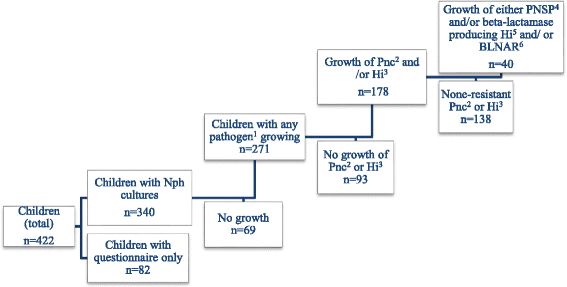Children with respiratory tract infections in Swedish primary care; prevalence of antibiotic resistance in common respiratory tract pathogens and relation to antibiotic consumption
- PMID: 28870173
- PMCID: PMC5583975
- DOI: 10.1186/s12879-017-2703-3
Children with respiratory tract infections in Swedish primary care; prevalence of antibiotic resistance in common respiratory tract pathogens and relation to antibiotic consumption
Abstract
Background: The majority of antibiotics consumed in developed countries are prescribed in primary care. However, little is known about resistance levels in the primary care population.
Method: Nasopharyngeal cultures were obtained from children, 0-10 years of age, seeking care at their Primary Health Care Centre with symptoms of respiratory tract infection. Parental questionnaires were used to retrieve information about the child's previous antibiotic consumption.
Result: Cultures from 340 children were gathered. The level of resistant Haemophilus influenzae was low and the prevalence of penicillin non-susceptible pneumococci (PNSP MIC ≥ 0.125 mg/L) was 6% compared to 10% (p = 0.31) in corresponding cultures from children diagnosed at the local clinical microbiology laboratory. Antibiotic treatment within the previous 4 weeks predisposed for resistant bacteria in the nasopharynx, OR: 3.08, CI 95% (1.13-8.42).
Conclusion: Low prevalence of PNSP supports the use of phenoxymethylpenicillin as empirical treatment for childhood upper respiratory tract infections attending primary care in our setting. It is important that studies on resistance are performed in primary care populations to evaluate data from microbiological laboratories. Recent antibiotic treatment increases risk of bacterial resistance in children and continuous work to reduce unnecessary antibiotic prescribing should be prioritised.
Conflict of interest statement
Ethics approval and consent to participate
The study was approved by the Ethical Review board at Lund University, (Dnr. 2013/ 513). Information about the study and a written invitation was given to the parents at arrival at the clinic and informed parental consent was obtained for each case.
Consent for publication
Not applicable.
Competing interests
The authors declare that they have no competing interests.
Publisher’s Note
Springer Nature remains neutral with regard to jurisdictional claims in published maps and institutional affiliations.
Figures

Similar articles
-
Antibiotic resistance. Epidemiology of resistance--respiratory tract infections.J Med Microbiol. 1997 Jun;46(6):442-5. J Med Microbiol. 1997. PMID: 9379469 No abstract available.
-
Antibiotic resistance of Streptococcus pneumoniae, isolated from nasopharynx of preschool children with acute respiratory tract infection in Lithuania.BMC Infect Dis. 2016 May 20;16:216. doi: 10.1186/s12879-016-1544-9. BMC Infect Dis. 2016. PMID: 27206423 Free PMC article.
-
Influence of child care on nasopharyngeal carriage of Streptococcus pneumoniae and Haemophilus influenzae.Pediatr Infect Dis J. 2003 Jul;22(7):589-92. doi: 10.1097/01.inf.0000073203.88387.eb. Pediatr Infect Dis J. 2003. PMID: 12867832
-
Respiratory tract infection: epidemiology and surveillance.J Chemother. 1997 May;9 Suppl 3:10-7. J Chemother. 1997. PMID: 9248976 Review.
-
[Prevalence and treatment for antibiotic-resistant bacteria in respiratory infection].Nihon Rinsho. 2007 Feb 28;65 Suppl 2 Pt. 1:502-7. Nihon Rinsho. 2007. PMID: 17455671 Review. Japanese. No abstract available.
Cited by
-
The consequence of financial incentives for not prescribing antibiotics: a Japan's nationwide quasi-experiment.Int J Epidemiol. 2022 Oct 13;51(5):1645-1655. doi: 10.1093/ije/dyac057. Int J Epidemiol. 2022. PMID: 35353127 Free PMC article.
-
Reduction of antimicrobial resistant pneumococci seven years after introduction of pneumococcal vaccine in Iceland.PLoS One. 2020 Mar 17;15(3):e0230332. doi: 10.1371/journal.pone.0230332. eCollection 2020. PLoS One. 2020. PMID: 32182260 Free PMC article.
-
Change in the use of diagnostic tests in the management of lower respiratory tract infections: a register-based study in primary care.BJGP Open. 2020 May 1;4(1):bjgpopen20X101015. doi: 10.3399/bjgpopen20X101015. Print 2020. BJGP Open. 2020. PMID: 32127365 Free PMC article.
-
Point prevalence surveys of antibiotic prescribing in children at a tertiary hospital in a resource constraint, low-income sub-Saharan African country-the impact of an antimicrobial stewardship program.BMC Pediatr. 2024 Jun 4;24(1):383. doi: 10.1186/s12887-024-04847-3. BMC Pediatr. 2024. PMID: 38834956 Free PMC article.
-
Antibiotic Resistance Among Pediatric-Sourced Ocular Pathogens: 8-Year Findings From the Antibiotic Resistance Monitoring in Ocular Microorganisms (ARMOR) Surveillance Study.Pediatr Infect Dis J. 2019 Feb;38(2):138-145. doi: 10.1097/INF.0000000000002206. Pediatr Infect Dis J. 2019. PMID: 30281547 Free PMC article.
References
-
- Swedres Svarm 2013 - Swedres-Svarm-2013.pdf [Internet]. [cited 2016 Oct 10]. Available from: https://www.folkhalsomyndigheten.se/pagefiles/17612/Swedres-Svarm-2013.pdf.
-
- Övervakning av barnvaccinationsprogrammet mot pneumokocker - overvakning-barnvaccinationsprogrammet-pneumokocker.pdf [Internet]. [cited 2016 Feb 10]. Available from: http://www.folkhalsomyndigheten.se/pagefiles/12871/overvakning-barnvacci....
-
- Pneumokocker med nedsatt känslighet för penicillin (PNSP) - pneumokocker-med-nedsatt-kanslighet-for-penicillin-pnsp-2012-5-13.pdf [Internet]. [cited 2016 Feb 10]. Available from: http://www.folkhalsomyndigheten.se/pagefiles/20446/pneumokocker-med-neds....
MeSH terms
Substances
LinkOut - more resources
Full Text Sources
Other Literature Sources
Medical

